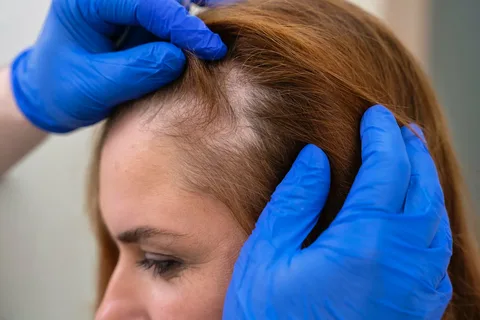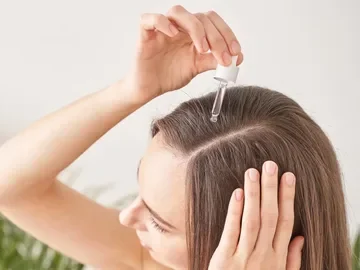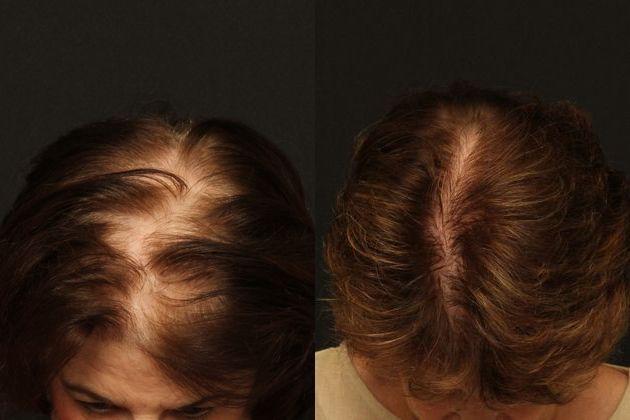Bleaching your hair can create a vibrant, lighter look, but for many, it also leads to an unexpected concern: hair loss after bleaching. If you’re noticing breakage or thinning after lightening your hair, you’re not alone. In this post, we’ll explain why it happens, how to recover quickly, and how to protect your hair moving forward. With expert advice and clear steps, you’ll regain your hair’s strength and shine—safely and confidently.
Understanding Hair Loss After Bleaching
The Science Behind Bleaching and Hair Damage
Hair bleaching uses strong chemicals, usually hydrogen peroxide or ammonia, to strip melanin from your hair. This process opens the cuticle and breaks down the hair shaft’s inner structure (cortex), leading to:
- Weakened bonds, especially keratin proteins
- Porous, brittle strands are more prone to snapping
- Increased friction during brushing or styling
Common Signs of Bleach-Induced Hair Loss
You might be experiencing bleach-related damage if you notice:
- Excessive shedding after washing
- Hair that feels elastic, mushy, or dry
- Noticeable thinning around the crown or temples
- Split ends and frequent breakage mid-shaft

Is Hair Loss After Bleaching Permanent?
Temporary vs. Permanent Hair Loss
Most post-bleaching hair loss is temporary and caused by hair breakage, not follicle damage. However, in rare cases, over-bleaching can lead to:
- Chemical burns on the scalp, damaging follicles
- Telogen effluvium, a stress-related condition causing sudden shedding
The good news? With the right care, your hair can often recover without medical treatment.
Factors Influencing Recovery
- Hair type: Curly and fine hair is more fragile
- Past treatments: Repeated coloring or heat damage increases vulnerability
- Scalp health: Inflammation or infections can delay regrowth
- Nutrition and stress levels: Poor diet or chronic stress can slow recovery
Recovery Timeline and What to Expect
Immediate Aftercare (First 2 Weeks)
- Stop all chemical treatments (dye, heat styling)
- Use sulfate-free, moisturizing shampoos
- Begin weekly deep conditioning and protein masks
Pro Tip: Look for ingredients like keratin, argan oil, and hydrolyzed proteins.
Short-Term Recovery (1–3 Months)
- Hair may feel stronger and less dry
- Reduced shedding if breakage is controlled
- Start incorporating scalp massage with nourishing oils (e.g., rosemary oil)
Long-Term Maintenance (3–12 Months)
- Trim split ends every 8–10 weeks
- Use bond-repair treatments (e.g., Olaplex, K18)
- Continue protein-moisture balance routines

Expert-Recommended Treatments and Products
Protein and Moisture Balance
Bleached hair needs both moisture (to hydrate) and protein (to repair structure). Alternate weekly:
- Moisture Masks: Shea butter, aloe vera, glycerin-based
- Protein Treatments: Hydrolyzed keratin, rice water rinse, collagen masks
Scalp Care and Stimulation
- Apply scalp serums with caffeine or niacinamide
- Massage your scalp daily for 5–10 minutes
- Avoid tight hairstyles and rough towel-drying
Recommended Products
- Shampoo: Olaplex No.4, Briogeo Don’t Despair, Repair!
- Conditioner: SheaMoisture Manuka Honey, Redken Extreme
- Treatment: K18 Leave-in Molecular Repair, ApHogee 2-Step Protein Treatment

Preventing Hair Loss in Future Bleaching Sessions
Pre-Bleach Preparations
- Perform a strand test
- Strengthen hair with protein treatments days before
- Avoid bleaching over freshly relaxed or permed hair
During Bleaching
- Use professional-grade products
- Limit bleach processing time
- Don’t overlap bleach onto previously bleached areas
Post-Bleach Care
- Rinse with cool water to seal cuticles
- Use leave-in protectants and UV filters
- Stick to heatless styling as much as possible
Expert Tip from Dr. Rana Irfan, Hair Restoration Specialist:
“Never bleach hair more than once in 6–8 weeks. Your scalp and strands need time to heal and rebuild.”
Frequently Asked Questions (FAQs)
How much hair loss is normal after bleaching?
Some shedding and breakage are expected. If you’re losing more than 100 strands per day, it may indicate chemical overprocessing or scalp irritation.
Can I bleach my hair again after experiencing hair loss?
It’s best to wait at least 3–6 months and consult a professional before re-bleaching damaged hair.
Are there any supplements that help with hair regrowth?
Yes. Look for biotin, zinc, and vitamin D. Always consult a doctor before starting new supplements.
When should I consult a professional about hair loss?
If your scalp burns, blisters, or if hair is falling out in clumps, see a dermatologist immediately.
Quotes from Trichologists and Dermatologists
“Bleaching compromises the integrity of hair fibers. Recovery isn’t just about products—it’s about time and consistency.”
— Dr. Hira Aslam, Trichologist
Case Studies
Case: Fatima, 28, Islamabad
After two bleaching sessions in one month, she experienced thinning and breakage. With consistent Olaplex treatments and a 3-month protein-moisture routine, she reported 70% improvement.

Book a Consultation with Our Hair Specialists in Islamabad
If you’re struggling with hair loss after bleaching, personalized care can make all the difference. Our clinic offers expert diagnosis, recovery plans, and targeted scalp therapies to help restore your hair’s health.
